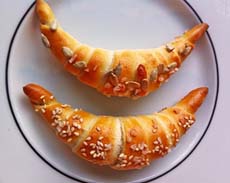Bread Glossary: A Glossary Of The Different Bread TypesPage 5: Bread Glossary G To L This is Page 5 of an 9-page article. Click on the red links below to visit other pages. This glossary is protected by copyright and cannot be reproduced in whole or part. You are welcome to link to it.
|
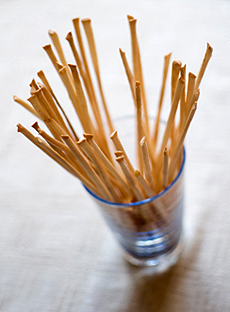 Classic Italian grissini (the singular form of the word is grissino). Photo by Martin Brink | IST. |
|
|
GARLIC BREAD Garlic bread is toasted bread—typically slices of baguette or other crusty loaf—spread with garlic butter. It is an excellent use for stale bread. A quick recipe: blend 4 cloves of crushed garlic into 4 tablespoons softened butter, olive oil or a combination of the two. Spread on toasted bread. Alternatively, slice a long loaf of bread on the diagonal, cutting almost to the bottom but leaving enough to keep the loaf attached. Spread slits with garlic butter and wrap loaf in foil. Bake in the oven at 350°F for 5 minutes; open foil and bake for another 5 minutes. Recipe variations:
|
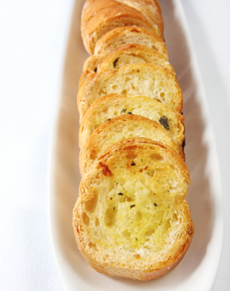 Garlic bread. Photo by Robyn Mac | IST. |
|
|
GENESIS 1:29 BREAD This bread has a cornucopia of seeds and grains. It’s named after Genesis 1:29: “Then God said, ‘I give you every seed-bearing plant on the face of the whole earth and every tree that has fruit with seed in it. They will be yours for food.’ ” While each baker can create his/her own recipe, one recipe from Food For Life includes: amaranth and chia from Central and South America, barley from Israel, black quinoa from the mountains of Peru, brown rice and spelt from the Far East, corn from Mexico, flax and rye from Northern Europe, kamut from Egypt, teff from the highlands of Ethiopia, millet and sorghum from the plains of Africa, pumpkin seeds from the Mediterranean, sesame seeds from the Near East, soy from China, spring wheat and Unprocessed Bran from Montana and sunflower seeds from the Dakotas. As you can imagine, it’s a highly nutritious loaf. See also Ezekiel bread. GRISSINI |
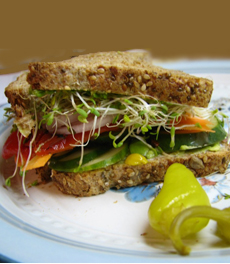 Genesis 1:29 bread from Food For Life. Photo courtesy Organic Gardens Network. |
|
| HOECAKE See cornbread. |
||
| HOT CROSS BUN A sweet yeast bun made with raisins or currants. The top is decorated with a cross made of icing (or more simply, by knife cuts in the dough). The cross symbolizes the crucifixion, and the buns are traditionally eaten on Good Friday; although they are believed to predate Christianity, eaten by Saxons in to honor the goddess Eostre (the cross is believed to have symbolized the four quarters of the moon; Eostre is probably the origin of “Easter”). The first recorded use of the term “hot cross bun” appears in 1733.
|
||
| INDIAN BREAD India is a large country with many regions; each has its preferred breads (all flatbreads), and different grains and blends are used in different regions. The styles vary from moist to dry, and leavened to unleavened Some are discussed further here: see chapati, dosa, naan and paratha. |
 Hot cross buns—delicious even at room temperature (photo courtesy Amy’s Bread). |
|
| INJERA A flatbread staple of Ethiopia, Eritrea, northern Kenya, Somalia and the Sudan, injera is a fermented sourdough bread that bakes into a spongy texture. It is baked in large, round pancake-like pieces and used instead of both plates and utensils. The Ethiopian way of eating includes scooping with injera. Stews and salads are placed upon the bread; pieces are torn up for eating.
|
 A plate of injera in a traditional woven Ethiopian server (photo courtesy AfricanMarket.com). |
|
| ITALIAN BREAD Italian bread is a generic term. In general, Italian bread is similar to French bread (also a generic term), but the loaves are shorter and plumper, while French loaves are longer and narrower. Here’s a discussion of the differences between Italian and French bread. |
||
| IRISH SODA BREAD A variety of white and brown soda breads are popular in Ireland, often containing raisins. See soda bread. |
||
| JEWISH RYE BREAD Jewish rye is a light rye bread, a mix of wheat and rye flours. Often, caraway seeds are included for extra flavor. |
||
| JOHNNYCAKE or JONNYCAKE A specialty from the Southern U.S., corn batter fried on a hot griddle or skillet and served with butter and jam. See cornbread.
|
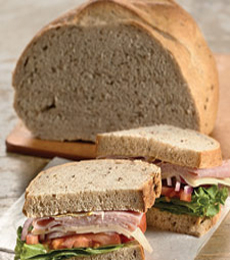 You can put anything on Jewish-style rye bread—including ham and cheese. Photo courtesy KingArthurFlour.com. |
|
| KHACHAPURI A Georgian (Russian) cheese bread that’s a variation of an Italian calzone. An oblong, individual portion of bread is filled with cheese and baked until the dough is cooked and the cheese inside is melted. For a hearty breakfast, eggs can be added. Here’s a recipe from Simply Home Cooked. |
||
| KIPFEL A kipfel is a crescent- or horn-shaped roll that is the progenitor of the croissant; Kipf is the German word for horn-shaped. There is also a crescent-shaped Jewish yeast pastry by the same name, filled with chopped nuts or fruit preserves, also called kipferln or rugalach.
|
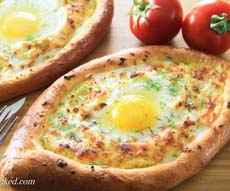 Khachapuri: Russian cheese bread, served here with eggs (photo courtesy SimplyHomeCooked. com). Below: Kipfel (photo courtesy ChefKoch.de).
|
|
| KNACKEBROD Swedish for crispbread, this rye-based thick cracker bread is a staple in Scandinavia and other northern European countries. Crispbread has been baked in Sweden since 500 C.E. It was made in large round wafers with a hole in the middle to store the bread on sticks and later, rods. They were baked just twice a year: following the fall harvest and again in the spring. Modern brands such as Ry-Krisp and Ryvita are made in individual rectangles, but beautiful artisan rounds, textured with a carved rolling pin, are still made.
|
 Traditional Swedish flatbread was round with holes for stacking (photo courtesy VisitSweden.com). |
|
| LAMINATION or LAMINATED DOUGH or LAMINATED PASTRY
Laminated dough is used to make Viennoiserie—brioche, croissants, danish and other buttery, flaky breakfast pastry. It is a time-consuming and expensive dough to make, owing to the large quantity of butter used. First, a yeast dough is made, called the détrempe (from the French verb, “to soak,” as the dry ingredients soak in liquid): milk, dry yeast, brown sugar, bread flour, and sea salt kosher salt are kneaded together. Some recipes use starter dough from a prior batch. The dough is chilled, then rolled out into a rectangle. A smaller rectangle of rolled out and chilled butter, called the beurrage (from the French word for butter, beurre), is placed on top of it. Then the construction of the pâton, or dough roll, begins. The rectangle is folded into thirds, as if folding a letter (in fact, this first fold is known as a “single letter fold”). The pâton is then refrigerated for an hour, rolled and folded again. The rolling and folding continues, usually for four turns. |
 Croissants are perhaps America’s favorite form of laminated pastry. Croissants available from Wolfermans.com. |
|
| LAVASH or LAHVASH or LAHVOSH Lavash is an Armenian flatbread made with wheat flour, water and salt. In the U.S., it is topped with toasted sesame seeds, poppy seeds, garlic and other seasonings. When fresh, lavash is soft and thin like a tortilla, and is used as a sandwich wrap for kebabs and other foods. It hardens into a crunchy cracker consistency, which is how it is most often found in the U.S.
LEAVENING or LEAVENING AGENT |
 Lavash is a Middle Eastern flatbread that has become popular in the U.S. Photo courtesy HotBreadOven.org. |
|
| LEVAIN Levain is a leavening agent or bread starter, also known in the U.S. as sourdough starter. It’s purpose is to develop the flavor of the bread. (While there is levain in sourdough bread, not all levain-based breads are “sourdough.” While “levain” means leavening, not all leavings are levain. There are cultivated (commercial) yeast leavenings and chemical leavenings such as baking powder and baking soda.) Levain is used instead of yeast to rise the dough in certain types of bread. The technique—and the starter—were developed in France in the 1600s. Levain is made from wild yeasts, and is less predictable than “foolproof” commercial yeasts. The latter can be relied upon to rise bread within a couple of hours, whereas starters take several days to make, and another two to three hours to rise the bread. Despite the lengthier time involved, artisan bakers prefer the results. To make levain, a mixture of water and flour is set out in the open for several days. This exposes the “starter” to the bacteria, fungus and yeast in the air. The fungus or yeast inhibit the growth of harmful bacteria, making the levain safe to use as a food. |
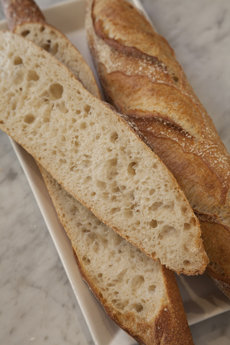 A baguette from Maison Kayser. Great pains are taken to prepare the homemade levain and ferment the bread. Photo courtesy Maison Kayser. |
|
| LOAF A bread or cake baked in a round or oblong pan with a rounded top. In the 12th century, “loaf” became the generic term for bread: The Teutonic word hlaf became our modern English word, loaf. Continue To Page 6: Terms Beginning With M To O Go To The Glossary Index Above
|
 A loaf of cardamom bread. Photo by Daniela Cuevas | THE NIBBLE. A loaf of cardamom bread. Photo by Daniela Cuevas | THE NIBBLE.
|
|
Last Updated Apr 2018
© Copyright 2005-2024 Lifestyle Direct, Inc. All rights reserved. All images are copyrighted to their respective owners.
